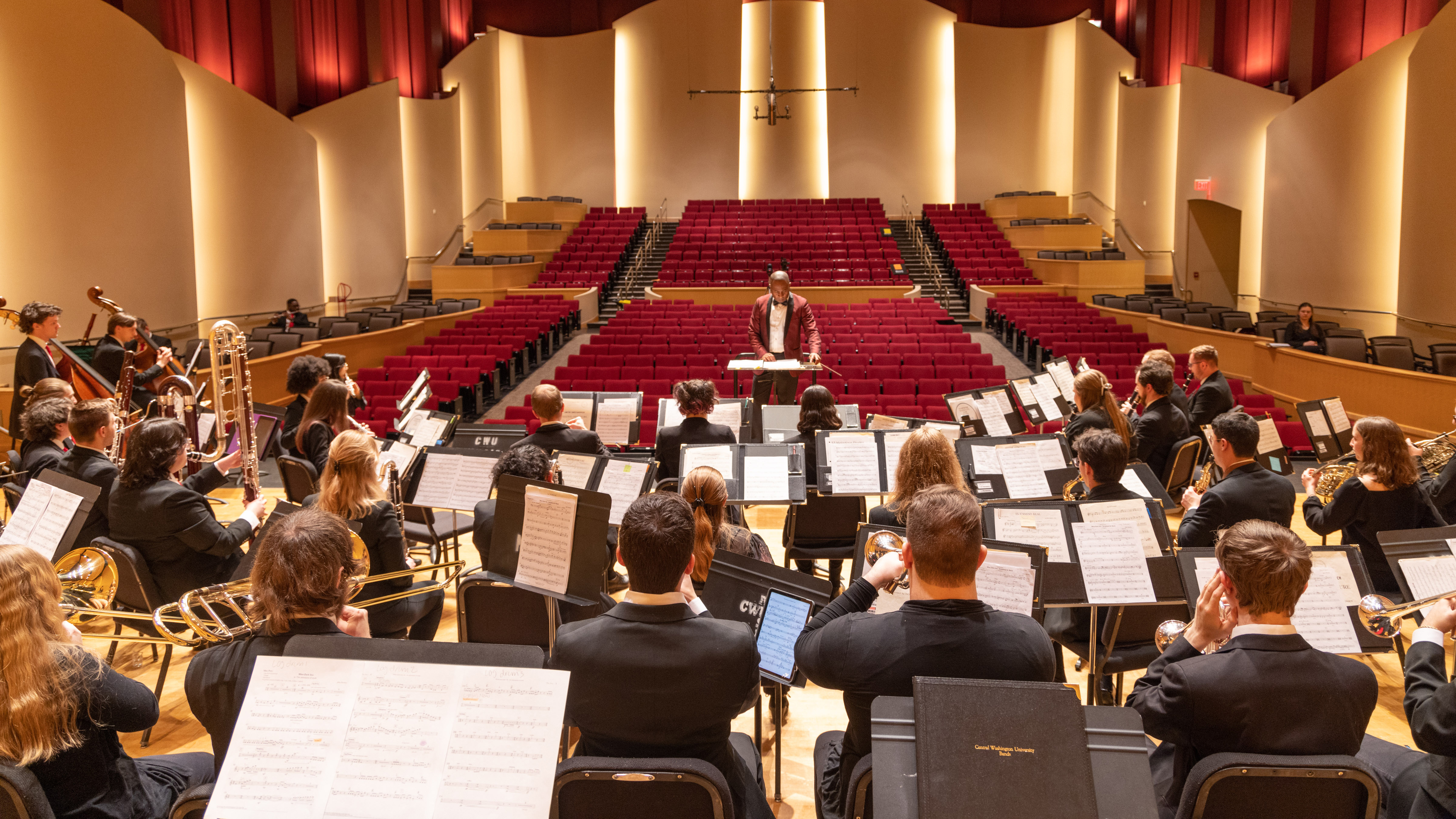
Music
Musicians Hearing and Health
General Musician Health Information
-
Performance Health
Anyone who practices, rehearses or performs instrumental or vocal music has the potential to suffer injury related to the activity. Students are encouraged to supplement information obtained in their lessons, master classes, and guest lectures regarding musicians' health and safety issues by utilizing some of the resources listed on this website.
Instrumental musicians are at risk for repetitive motion injuries or physical problems related to playing their instruments; and if they are also computer users, their risks are compounded. Instrumental injuries may include carpal tunnel syndrome, tendonitis, and bursitis.
Likewise, the demands placed on singers' voices are vast. Singers can be forced to cancel a recital or tour, take a break, or undergo a medical procedure due to problems with their voice. Vocalists can suffer from vocal fatigue, anxiety, throat tension, and pain. Musicians use their bodies in specific and highly trained ways, and injuries can occur that can have lasting impact on performance ability. Performers need to be aware of vocal and musculoskeletal health issues that can affect them. Musicians at all levels of achievement can suffer from repetitive stress injuries, neuromuscular conditions or dystonias, and psychological issues including severe performance anxiety.
Incorrect posture, non-ergonomic technique, excessive force, overuse, stress, and insufficient rest contribute to chronic injuries that can cause pain, disability, and the end of a musician's career. Additional factors such as nutrition, smoking, drug use, noisy environments, and proper training (or the lack of it) all play a role in a musician's ability to perform at her/his best.
-
Hearing Health
(Adapted from "Protecting Your Hearing Health" by NASM-PAMA)
- Hearing health is essential to your lifelong success as a musician.
- Your hearing can be permanently damaged by loud sounds, including music. Technically, this is called Noise-Induced Hearing Loss (NIHL). Such danger is constant.
- Noise-induced hearing loss is generally preventable.You must avoid overexposure to loud sounds, especially for long periods of time.
- The closer you are to the source of a loud sound, the greater the risk of damage to your hearing mechanisms.
- Sounds over 85 dB (your typical vacuum cleaner) in intensity pose the greatest risk to your hearing.
- Risk of hearing loss is based on a combination of sound or loudness intensity and duration.
- 85 dB (vacuum cleaner, MP3 player at 1/3 volume) – 8 hours
- 90 dB (blender, hair dryer) – 2 hours
- 94 dB (MP3 player at 1/2 volume) – 1 hour
- 100 dB (MP3 player at full volume, lawnmower) – 15 minutes
- 110 dB (rock concert, power tools) – 2 minutes
- 120 dB (jet planes at take-off) – without ear protection, sound damage is almost immediate
Certain behaviors (controlling volume levels in practice and rehearsal, avoiding noisy environments, turning down the volume) reduce your risk of hearing loss. Be mindful of those MP3 earbuds. See chart above.
The use of earplugs and earmuffs helps to protect your hearing health.
Day-to-day decisions can impact your hearing health, both now and in the future.
Since sound exposure occurs in and out of school, you also need to learn more and take care of your own hearing health on a daily, even hourly basis.
It is important to follow basic hearing health guidelines. It is also important to study this issue and learn more. If you are concerned about your personal hearing health, talk with a medical professional. If you are concerned about your hearing health in relationship to your program of study, consult the appropriate contact person at your institution. -
Hearing Conservation Policy
As good hearing is crucial to musicians, and data collected in the average music school practice room, teaching studios, and rehearsal rooms found average intensity values that were greater than OSHA action levels for a hearing conservation program, therefore Central Washington University Department of Music has instituted a Hearing Loss Prevention Program for all students. Occupational hearing loss is insidious, slowly advancing for many years before individuals are aware of their impairment. This type of hearing loss is not medically treatable and is permanent.
All new students will attend a yearly instructional program that includes motivational information about:
- Anatomy & physiology of hearing
- How acoustic overexposure damages the ear
- How this damage affects hearing
- How to prevent the damage
- How to use hearing protective devices
In addition, all faculty will be instructed in the importance of the program and on ways they can be instrumental in the prevention of hearing problems in students. Faculty will also be encouraged to have their own hearing tested annually.
-
Environmental and Genetic Factors
Environmental Factors in Susceptibility to Noise-induced Hearing Loss in Student Musicians
Hearing threshold and survey data collected over three years in a school of music shows that 52% of undergraduate music students show declines in high frequency hearing at 6000 Hz consistent with acoustic overexposure. Declines at 4000 Hz have grown in number over the three years, from 2% the first year to 30% the third year. These "noise notches" are seen in all instrument groups, including voice, and are seen more in the right ear than the left ear in all groups. Exposure to outside noise does not appear to be a determining factor in who develops these declines. It is concluded that genetic predisposition is a likely risk factor.
Genetics of Noise-induced Hearing Loss in MusiciansHearing threshold and survey data collected over three years in a school of music shows that 52% of undergraduate music students show declines in high frequency hearing at 6000 Hz consistent with acoustic overexposure. Declines at 4000 Hz have grown in number over the three years, from 2% the first year to 30% the third year. These "noise notches" are seen in all instrument groups, including voice, and are not associated with any particular instrument. Among music students, 13.5% show indications of hearing loss in both ears, despite no indications of unusual noise exposure or ototoxicity. Further, hearing loss is asymmetric, with notches occurring more frequently in the right ear of musicians showing unilateral hearing loss and more deeply in the right ear of those students with a bilateral hearing loss. By contrast, this directionality of hearing loss is not as pronounced in nonmusic students, suggesting that an affective process may be involved. The results further suggest that some students are genetically predisposed to noise-induced hearing loss.
-
Sound-level Measurements in Music Practice Rooms and Ensembles
Sound-level Measurements in Music Practice Rooms
Average sound levels and percent of daily dose of noise exposure were measured in the practice rooms of a university school of music, with the primary objective of determining whether sound level in student practice rooms were high enough to warrant concern for hearing conservation. A secondary objective was to determine whether any instrument group was at higher risk for music-induced hearing loss due to exposure levels. Students representing four musical instrument groups were represented: brass, wind, string and voice. Measurements were taken using a dosimeter or doseBadge clipped to the shoulder during 40 student's individual practice sessions. These readings provided average exposure levels as well as the percentage of total allowed exposure (dose) obtained during the practice session. Mean sound levels measured averaged 87-95 dBA, which is in excess of levels used by the ISO/NIOSH to determine the necessity of implementing a hearing conservation program in industrial settings. Mean average levels for the brass players were significantly higher than other instrumentalist groups. Implications for career musicians are discussed, including the need for 12-hour breaks and the use of musician's earplugs. The implementation of a Hearing Protection Policy in the School of Music is also discussed.
Sound Level Exposures in Music EnsemblesThe noise exposure of musicians participating in bands and orchestras has been studied on a limited basis for the last 35 years. Excessive noise exposure can eventually lead to noise-induced hearing loss. Therefore, the purpose of this study was to determine whether wind band members at a mid-sized university were exposed to excessive levels of noise. Data were collected from 46 members of three concert bands across one week's time. Fifty-two percent of subjects experienced one or more rehearsals a week with sound levels greater than 100% (as defined by the National Institute of Occupational Safety and Health). Since a 100% sound dose is the maximum exposure recommended by NIOSH (daily) for preventing noise-induced hearing loss, it was determined that university wind band members should have additional education relative to preserving their hearing and the use of hearing protection devices.
Summer band camp is a routine part of participation in most high school marching bands where members gather to rehearse for marching band performances at football games and parades. Since marching band most frequently occurs outdoors, it is unknown whether members experience excessive noise exposure while participating in marching band. Therefore, the purpose of this study was to determine what levels of noise students experience when participating in high school marching band during band camp. Data were collected from 16 high school students in a 100-member marching band during a five-day camp. After a preliminary descriptive analysis, results indicate that fifteen of sixteen subjects experienced noise exposure in excess of 300%. (One hundred percent is the maximum allowable dosage per day according to the National Institute for Occupational Safety and Health.) Therefore, it is incumbent upon music teachers to educate our elementary, middle, and high school students about the potential risks of noise-induced hearing loss and the different methods of hearing protection.
-
Hearing Health of Public School Music Teachers
The sense of hearing is important for human communication, and an acute sense of hearing is critical for accuracy relative to music communication. Music teachers are exposed to loud music sounds during most of the hours spent in school. The hearing system, although resilient, is susceptible permanent damage when stressed beyond safe limits. And for music teachers, anything less than an acute sense of hearing can be devastating.
The current study was designed to describe the sound-level exposures of public school music teachers, and to address the following research questions. Do public school music teachers experience sound levels that result in dose percentages that meet or exceed standards recommended by the National Institute for Occupational Safety and Health (NIOSH) during typical work days?
Eighteen public school music teachers participated in this study. With the exception of two music teachers, each music teacher wore a personal dosimeter (Cirrus® CR-100B doseBadge) across two complete work days (n = 34 days). Because of a malfunction in the doseBadges, dosimeter measures for two music teachers were collected for only one day (n = 2 days). In an effort to accommodate the music teachers' schedules that alternate daily (i.e., A Day/B Day), the researchers decided to measure two work days. This decision also was important for the music teachers who did not have alternating schedules; occasionally, their teaching schedules unexpectedly changed. A total of 34 days of sound-level exposures during public school music teaching were measured within the current study.
Across all music teachers, measured times ranged from 4:26 (i.e., hrs:mins) to 8:52. The shortest measured time of sound-level exposure was due to statewide testing. Daily average sound-level exposures ranged from 75.7 dBA (elementary choral/general music teacher) to 90.4 dBA (high school band teacher). Daily dose percentages based on NIOSH recommendations ranged from 6.0% (elementary choral/general music teacher) to 261.0% (high school band teacher).
Although the risk of hearing loss to music teachers is not new, the problem has received insufficient attention from researchers in music education. Because noise-induced hearing loss is a problem among music teachers, additional research and providing information to prospective and current members of the music education profession are essential to reducing and preventing NIHL among music teachers.
Sound-level Exposure and Risk of Noise-Induced Hearing Loss Experienced by University Music Performance Teachers
Hearing is a sense that is important for human communication, and critical for accuracy relative to communication of musical ideas. Although audiologists and environmental labor specialists have studied the effects of sound levels on human hearing, musicians have largely been ignored as a population to be considered for research related to hearing conservation. Recently, researchers have become interested in studying the effects of sound-level exposure of music on hearing acuity and the possibility of music-related noise-induced hearing loss (NIHL).
Thirty-seven university music performance teachers in the School of Music at UNCG participated. These participants included teachers of voice, keyboard, woodwinds, brass, strings, or percussion, and of vocal and instrumental conducting. In addition to faculty who provide individual and group instruction, two pianists who provide accompaniment also participated. Each participant wore a personal dosimeter (Cirrus® CR-100B doseBadge) across two complete work days. Days measured represented participants' teaching schedules (e.g., longer and shorter teaching days).
Results indicated that thirteen music performance teachers (35%) experienced dose percentages exceeding standards for at least one day. When dose percentages were averaged across both days, 12 (32%) teachers exceeded recommended standards.
At the outset of this study, nearly all participants were interested in knowing sound-level exposure of teachers of large vocal and instrumental groups. The assumption was that those participants would experience the most intense sound levels of all participants. What was found, however, was that while directors of large ensemble did experience very intense sound levels during rehearsals that occurred for either one hour each day one hour and 15 minutes twice per week, but the remainder of their teaching day was relatively quiet. While teachers of strings, keyboard (piano), choral conducting, and instrumental conducting run a very low risk of experiencing dose percentages greater than 100%, others certainly are at risk.
At least one participant in each of the teaching groups of woodwind, brass, percussion, voice, accompanying, and jazz conducting had a daily sound dose of greater than 100%. According to results of this study, teachers of students who play brass instruments have approximately 100% chance of experiencing 100% or greater daily sound dose percentage (NIOSH/ISO). Those whose teaching assignments are percussion, jazz conducting (and lessons), and accompanists have about a 50% chance of experiencing 100% or greater daily sound dose percentage (NIOSH/ISO). Given the acoustic power of these instruments, these findings were not surprising. However, the high dose percentages (i.e., 181% - 727%) were surprising.
Even though some participants did not experience 100% daily dose, they would benefit from using hearing protection during specific, and very sound intensive (loud) teaching activities. In no way should this line of research discourage music making and music teaching. Rather, this research should serve to educate musicians as to certain music activities during which they should use hearing protection.
-
Sound Shields: Effectiveness of Reducing Sound-Level Exposure to Musicians
Student musicians are expected to perform in university ensembles. Many of these instrumental ensembles expose students to high levels of noise. Previous data has indicated that the noise levels are high enough to place students at risk for a noise induced hearing loss. In an attempt to find a way to reduce noise levels of ensembles at UNCG, three acoustic shields were tested within the University Orchestra, Wind Ensemble, Symphonic band, and University Band. By comparing noise levels experienced by students using a sound shield to those without the shield, the effectiveness of the protection was determined. It was found that even with the shields, students were still exposed to a high level of noise, leaving them at risk for a noise induced hearing loss. Noise levels experienced by professional orchestral musicians are now under investigation.
-
Heath Care Providers and Additional Resources
Hearing Healthcare Specialist
Northwest Hearing & Audiology
Linda Lee Nelson, MSPA, CCC-A
Certified Clinical Audiologist
603 N. Main Suite #2
Ellensburg, WA 98926
(509)962-9575Ear Plug Sites
CWU News

Latest edition of Voyage Magazine available online
April 24, 2024
by University Relations

CWU defensive standout presented with coveted national award
April 24, 2024
by David Leder